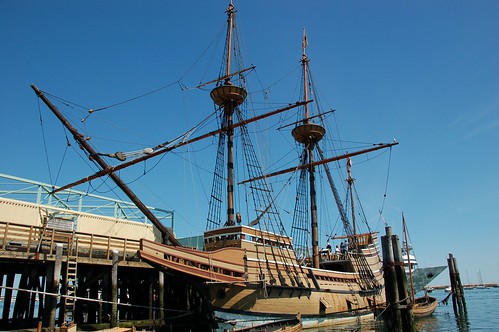From the time of our first history lesson in kindergarten or preschool, we know the term “Mayflower.” But despite the fact that one of the most famous -if not the most famous – ship in North American history was called the Mayflower, I just sort of assumed the name referred to any old flower that bloomed in May and left it at that. And I kind of doubt the Pilgrims put a whole lot of thought into the flower either. They probably didn’t care what their ship was named, let alone what flower it was named after, as long as it put an ocean between themselves and the religious persecution of King James I.
Occasionally I’d run into a Mayflower moving truck and that would make me think about mayflowers for about .2 seconds, but generally, mayflowers were out of mind more often than not.
But when I read Anne of Green Gables for the first time as a teenager, I ran into mayflowers yet again.
“‘I’m so sorry for people who live in lands where there are no Mayflowers,’ said Anne. ‘Diana says perhaps they have something better, but there couldn’t be anything better than Mayflowers, could there, Marilla? And Diana says if they don’t know what they are like they don’t miss them. But I think that is the saddest thing of all. I think it would be tragic, Marilla, not to know what Mayflowers are like and not to miss them. Do you know what I think Mayflowers are, Marilla? I think they must be the souls of the flowers that died last summer and this is their heaven.'”
In fact, mayflowers must have been very significant to Canadian author L.M. Montgomery, because she makes mention of them in at least of three of her eight books that deal directly with the life of Anne Shirley Blythe, aka Anne of Green Gables. In later books, Anne’s son, Jem, makes a habit of collecting bouquets of mayflowers each spring for his mother. This becomes particularly poignant in Rilla of Ingleside when Jem enlists in the Canadian Army at the start of World War I and is unable to bring Anne her mayflowers during the first spring of the Great War.
Despite reading the entire Anne of Green Gables series all the way through at least three or four times, I never really knew what these mayflowers looked like. At one point Anne’s daughter, Rilla, makes mention of wanting to gather armloads of mayflowers, so I always assumed the mayflower was a bigger wildflower like a daisy or black-eyed Susan.
At long last, I decided to consult the font of all knowledge, Google, to figure out what these mayflowers actually look like.
And low and behold I came up with a photo of this, a wildflower we know very well on the Gunflint Trail:
We call it “false lily of the valley,” but in other parts of North American it’s referred to by the English translation of its scientific name Maianthemum canadense: Canada Mayflower.
But despite having photographic proof of what a Canada mayflower looks like, I had a hunch that I hadn’t quite cracked “the mayflower mystery.” For one thing, how Rilla planned to gather armloads of these, I wasn’t quite sure, since the flower stalks average only about 4.5″ in height. At best, a “bouquet” of these mayflowers would really be more of a “nosegay.” For another thing, context clues in Anne of Green Gables told me that on Prince Edward Island where the books are set mayflowers bloom before violets. Here in Minnesota, false lily of the valley blooms decidedly after the violets.
It turns out that in the Maritime provinces where L.M. Montgomery lived, the wildflower known as trailing arbutus is often referred to as a mayflower. Never mind that in the Maritimes, trailing arbutus blooms in April. The reason for this Canadian misnomer for trailing arbutus brings us right back to those pilgrims and refers to the fact “that it was the first flower to cheer the hearts of the Pilgrim Fathers after the rigors of their first New England winter.” The whole “bouquet” thing that L.M. Montgomery mentions to is still confusing, because again, trailing arbutus only grows to 4-6″ tall so good luck finding a vase to accommodate that bouquet, but there you have it.
I’ve been thinking about L.M. Montgomery a lot lately, because the mother of two dear friends passed away unexpectedly at the end of last month. She was a noted L.M. Montgomery researcher, deeply involved with the L.M. Montgomery Literary Society, who visited Prince Edward Island many times, although never at the time when mayflowers were blooming, I don’t think. Because it’s springtime, I keep thinking of little Jem, scrambling down the hillside in Rainbow Valley to gather mayflowers for his mother.
So I’ve been watching carefully for our version of mayflowers this spring. They’re not out quite yet, but their large (at least in comparison with their flower) heart-shaped leaves are spreading across the forest floor. It wasn’t until I was leafing through my Anne books looking for mayflower references last night, that I rediscovered her quote about mayflowers being “the souls of wildflowers.” I thought about the tiny star-shaped flowers along a stem of false lily of the valley and was impressed by how apt that description seemed for the mayflower I know and the mayflower Anne knew.
Regardless of which mayflower you see this spring, I hope they’re a peaceful patch of beauty, with just a hint of mystic.




